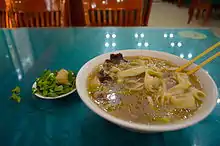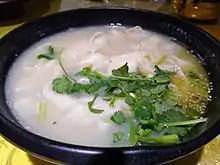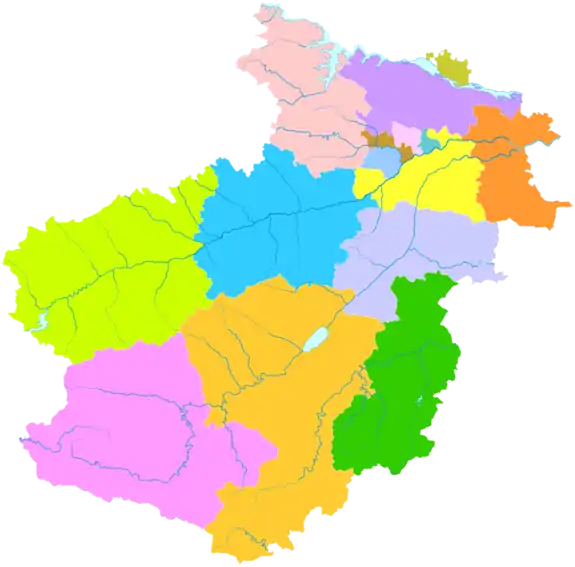Hui mian
Hui mian (Chinese: 烩面) is an important noodle-based food originating in China. It is a common food in Henan Province. Hui mian has a long history in Henan and is connected with Henan in the present day. The ingredients used in Hui mian differ in regards to different cities and restaurants branding.[1]


History
The Hui mian recipe is widespread and originated in the Tang dynasty. A country lady invented Huimian when she tried to make a type of nutritious noodles for Li Shimin, the later emperor, to help him recover strength when he was starving while on the run during a war. Li loved the dish, so Li found the lady a year later after he became the emperor of the Tang Dynasty. The emperor commanded the royal chefs to study the Hui mian recipe from that lady. Hui mian became a secret food in royal families. Centuries later, in the late Qing Dynasty, when the Eight-Nation Alliance invaded China, the Empress Dowager Ci Xi was recorded that she had Hui mian a lot during the run of the war; There were records of Empress Ci Xi talking about " Hui mian can dispel cold". Until the end of the Qing Dynasty, the royal chef Pang Enfu escaped from the Forbidden City and lived in seclusion in Henan. He started teaching normal people to cook Hui mian, then Hui mian began spreading among common people in the society.[2]
Variations
Henan is in the central area of China, and it is a province famous of Hui mian. Most of Hui mian in the Henan area is the descendant of royal food Hui mian. The province has more than a hundred million people. Hui mian has developed in many different styles based on each population group, and ethnic group.
Yang Fu Yan (杨府宴) Hui mian
Yang Fu Yan Hui mian has become famous in recent years in Henan. The Yang Fu Yan recipe Hui mian follows the traditional cooking style of Hui mian, using only mutton and beef as broth which is different with many other new developed recipe using mutton or beef with pork.[3]
Heji Lamb Hui mian
Heji Lamb Hui mian is a Halal Hui mian. In May 1994, Heji Hui mian won the award of "all of the famous brand name of food" in China. In December 1997 it won the title of "Chinese famous snacks". The predecessor of Heji style is the Old Folks Hotel and Restaurant in Zheng Zhou. In 1953, Li Shaoqing and other 4 people were in charge of the hotel management, so they changed the name "Heji restaurant"; "Heji" means "many people manage together" in Chinese. Since 1967 specializing in lamb noodle, they renamed "Heji (合记) Lamb Hui mian", commonly known as "Heji".
Xiaoji (萧记) Sanxian (三鲜) Hui mian
Xiao ji Sanxian Hui mian is another commonly known Hui mian style in Henan. Xiaoji Sanxian Hui mian's founder Xiao Honghe was a Yifu mian(伊府面) chef in Zhengzhou government-owned Changchun Hotel. After retirement from the government-owned restaurant, he and his two sons opened a Hui mian restaurant. He did not follow traditional mutton Hui mian recipe, but he found his special recipe from the inspiration of Yifu noodles by adding Sanxian ingredients to the original mutton or beef broth. Sanxian means using a combination of three umami dressing ingredients, which are commonly indicating sea cucumbers, fresh mushrooms, and baby bamboos. In nowadays, people use different three dressing ingredients as long as from categories of seafood, fungus, and fresh vegetables can also be called as Sanxian Hui mian.
Modern Hui mian storage process
Due to modern technology and demand, many university labs in Henan have developed Hui mian instant storage in order to keep the taste and easy for people to transit and eat. The best way is "instant frozen".[4]
See also
References
- "中国的十大面条你们喜欢哪个?". www.douban.com. Retrieved 2020-02-18.
- "河南八大特色美食历史追溯:烩面起源清朝 - 河南一百度". www.henan100.com. Retrieved 2020-02-18.
- "开8家餐饮店回头客超四成 杨府宴的独家"食材经"了解一下_网易订阅". dy.163.com. Retrieved 2020-02-18.
- 陆启玉; 雷万学 (2002). "烩面的速冻和冷藏条件的研究". 郑州工程学院学报. 23 (2): 14–18.


